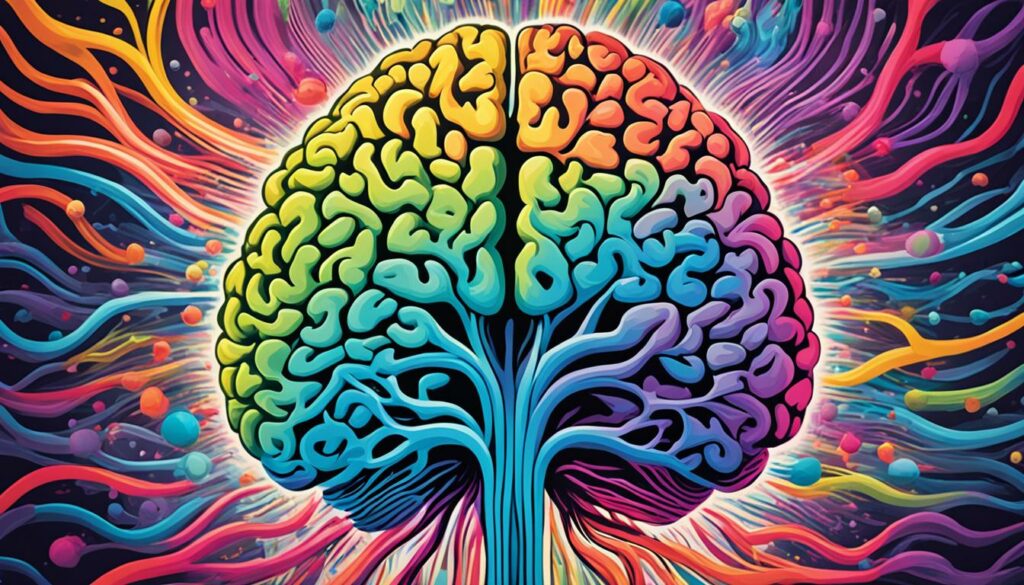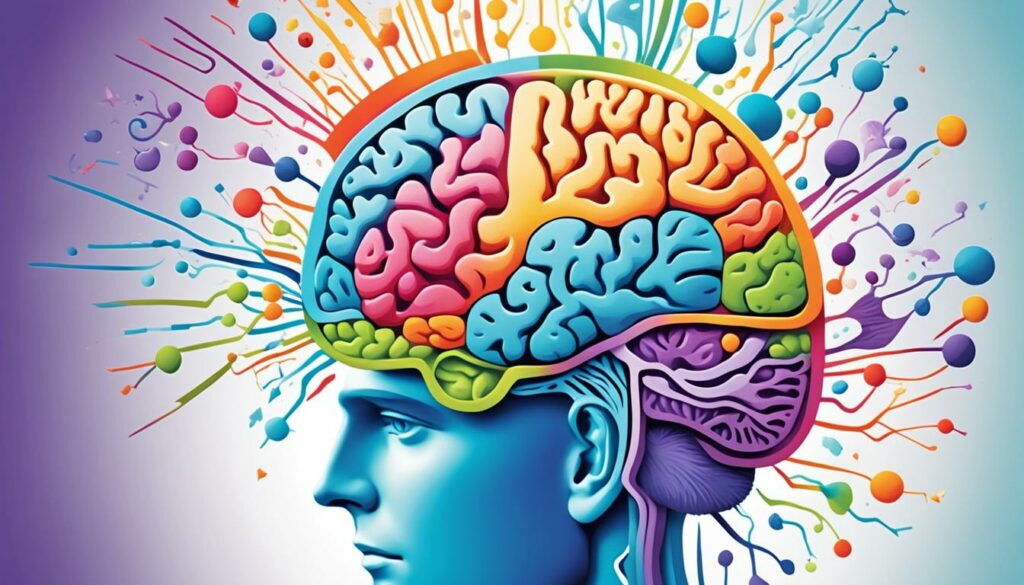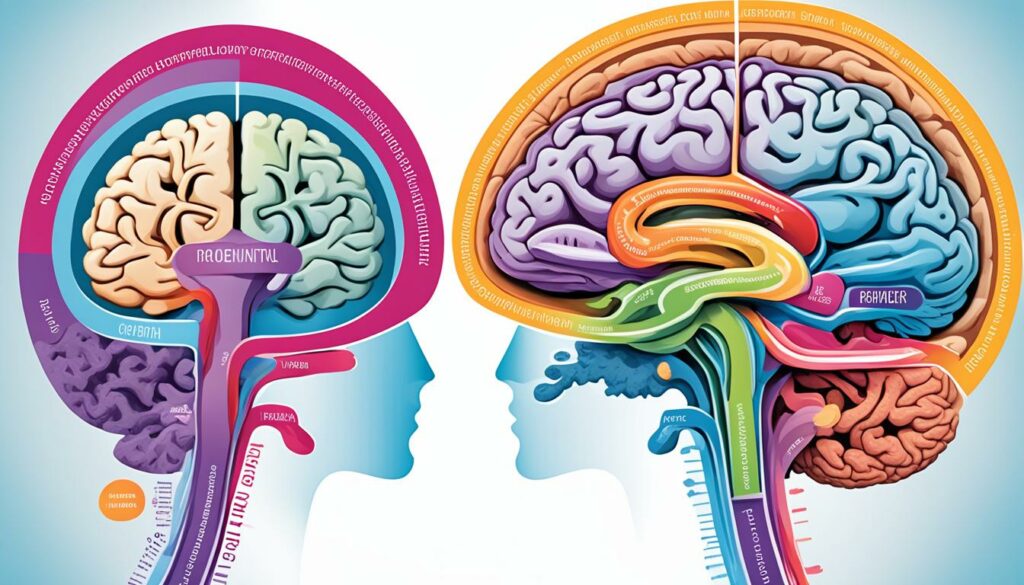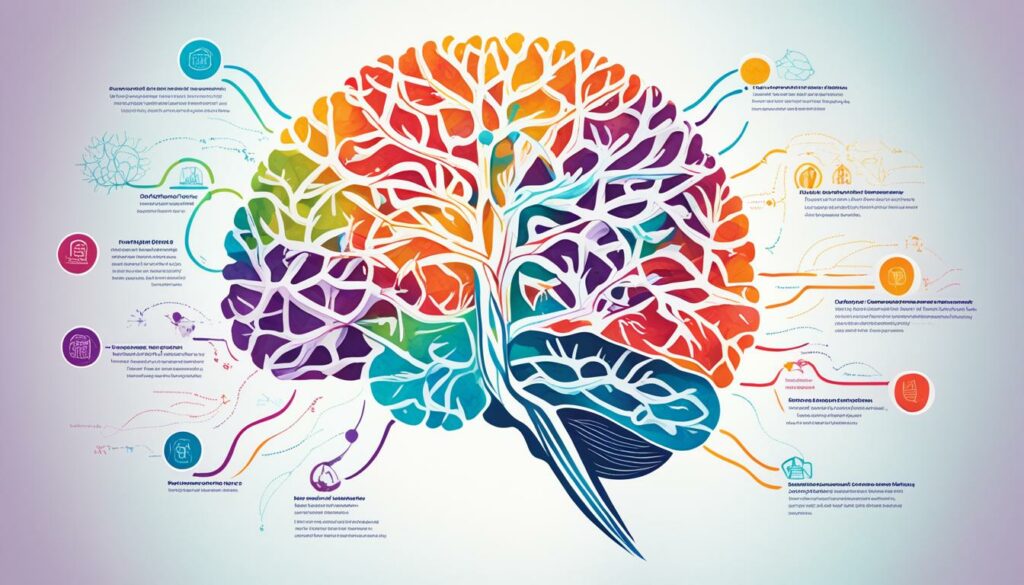Brain Development Timeline: When Does It Stop?
Understanding brain development is crucial for individuals in all stages of life, from parents raising children to educators shaping young minds. The brain is a complex organ that undergoes significant growth and changes throughout our lives. But when does the brain stop developing?
The brain stops growing in size by early adolescence, but that does not mean it has reached its full potential. In fact, the brain continues to develop and mature until the mid-to-late 20s. During this period, the prefrontal cortex, which is responsible for skills like planning and decision-making, is one of the last parts of the brain to mature.
Understanding the timeline of brain development is essential for providing the right support and guidance to individuals, especially during crucial phases like adolescence.
Key Takeaways:
- The brain stops growing in size by early adolescence but continues to develop and mature until the mid-to-late 20s.
- The prefrontal cortex, responsible for skills like planning and decision-making, is one of the last parts of the brain to mature.
Importance of Adolescence in Brain Development

During adolescence, although the brain has stopped growing in size, it continues to undergo significant development and fine-tuning. One crucial aspect of brain maturation during this stage is the growth and refinement of the prefrontal cortex.
The prefrontal cortex, located at the front of the brain, plays a crucial role in higher cognitive functions such as planning, prioritizing, and decision-making. It is responsible for executive functions that are essential for navigating the complexities of adult life.
Adolescence is a critical period for the maturation of the prefrontal cortex. As the brain undergoes these changes, teenagers develop the ability to think critically, solve problems, and regulate their behaviors. They begin to understand consequences and make more informed decisions.
Maturation of the Prefrontal Cortex
The prefrontal cortex is unique in its prolonged development, continuing well into the mid-to-late 20s. This extended maturation period allows the brain to fine-tune its neural connections, strengthening the circuits responsible for cognitive control and emotional regulation.
“Adolescence is a time of incredible growth and change in the brain. The prefrontal cortex, which is responsible for complex decision-making and self-control, undergoes significant development during this period.” – Dr. Sarah Johnson, Neuroscientist
As the prefrontal cortex matures, teenagers become more efficient in planning and organizing their thoughts, considering multiple perspectives, and making sound judgments. These developmental changes in the brain set the stage for young adults to navigate the challenges of adulthood and thrive in various aspects of life.
Impact on Brain Development
The maturation of the prefrontal cortex during adolescence has profound implications for brain development. It enables teenagers to develop crucial skills necessary for successful adulthood, including setting goals, managing time, and making sound and informed decisions.
Furthermore, the development of the prefrontal cortex allows teenagers to better regulate their emotions and impulses. This ability to self-regulate and control impulsive behaviors is essential for maintaining healthy relationships, performing well academically, and making responsible choices.
Adolescence is a transformative period where the brain undergoes significant changes and growth. This period of brain development not only impacts cognitive functions but also shapes a teenager’s personality and social interactions. By understanding the importance of adolescence in brain development, we can provide the support and guidance necessary for teenagers to thrive during this critical phase of life.
Social Experiences and Brain Development
During adolescence, the brain undergoes significant changes in areas responsible for social processes, shaping how teenagers perceive and engage with the world around them. These changes can result in a stronger focus on peer relationships and social experiences, as adolescents seek to establish their identities and navigate the complexities of social interactions.
The ongoing development of the prefrontal cortex, a region crucial for higher-order cognitive functions and decision-making, further influences the role of social experiences in brain development. As the prefrontal cortex matures, adolescents gain a greater understanding of social norms, empathy, and self-awareness, enhancing their ability to navigate and respond to social situations.
In the context of peer relationships, adolescents often seek validation and acceptance within their social circles. The desire to fit in and be accepted by peers can influence behavior and decision-making, as they navigate social hierarchies and establish their identity. This heightened emphasis on peer relations, combined with ongoing prefrontal cortex development, can result in teenagers taking more risks in order to gain social approval or experience social rewards.
Key Takeaways:
- Adolescence brings changes to the brain’s social processing areas.
- These changes lead to a stronger focus on peer relationships and social experiences.
- The ongoing development of the prefrontal cortex impacts the role of social experiences in brain development.
- Adolescents may take more risks in their social interactions to seek validation and acceptance from peers.
Impact of Social Experiences on Brain Development
| Positive Influence | Negative Influence |
|---|---|
| Enhancement of empathy and understanding of social norms | Risks of negative peer influence leading to risky behaviors |
| Strengthening of social skills and communication abilities | Peer pressure and potential exposure to harmful substances or behaviors |
| Formation of supportive peer relationships and social connections | Potential for exclusion, bullying, and social stress |
| Opportunities for collaboration, teamwork, and personal growth | Challenges in managing conflicts and navigating complex social dynamics |
Adaptability of the Teen Brain

The teenage brain is an incredibly adaptable organ, capable of responding and adjusting to new experiences and situations. This adaptability plays a crucial role in shaping the overall development and maturity of the brain.
One way to foster and enhance the adaptability of the teen brain is through engagement in challenging classes. By tackling complex academic subjects, teenagers can stimulate their brain circuits, developing critical thinking skills and problem-solving abilities.
Physical exercise is another powerful tool for promoting adaptability in the teen brain. Regular exercise has been shown to improve cognitive function and enhance neuroplasticity, the brain’s ability to change and reorganize itself in response to new experiences. Including activities like sports, dance, or even regular walks in daily routines can contribute to a more adaptable teenage brain.
“The teenage brain has an impressive capacity for change, allowing teenagers to quickly learn new skills, adapt to new environments, and navigate the challenges of adolescence.”
Creative activities, such as art and music, also play a significant role in enhancing adaptability. Engaging in artistic pursuits encourages self-expression and fosters the development of unconventional thinking skills. These activities activate brain circuits associated with creativity and innovation, promoting adaptability and flexibility in the teenage brain.
It is important to recognize and support the adaptability of the teen brain. By providing opportunities for challenging academics, physical exercise, and creative expression, we can help teenagers strengthen their brain circuits and cultivate a more adaptable mindset, contributing to their overall brain development and resilience.
Response to Stress and Mental Health

The developing teenage brain undergoes significant changes that can impact how it responds to stress. This heightened stress response can contribute to the development of mental illnesses such as anxiety and depression in teens.
During adolescence, the brain’s stress response system, known as the hypothalamic-pituitary-adrenal (HPA) axis, undergoes changes that make it more sensitive to stressors. This increased reactivity can lead to an overactive stress response, resulting in higher levels of stress hormones like cortisol circulating in the body.
Teen brain
The developing teenage brain may respond differently to stress, increasing the likelihood of stress-related mental illnesses like anxiety and depression.
Continual exposure to stress and prolonged activation of the stress response can have detrimental effects on the teen brain. It can interfere with the development of key brain regions involved in emotional regulation and decision-making, such as the prefrontal cortex.
It is crucial for teenagers to recognize their stress triggers and develop effective coping techniques to manage stress. Learning healthy ways to navigate stress can help reduce the risk of developing mental health issues. This may include practicing relaxation exercises, engaging in physical activity, seeking support from trusted individuals, or engaging in creative outlets.
By addressing and managing stress, teens can safeguard their mental health and support their overall well-being.
Quotes:
“The developing teenage brain may respond differently to stress, increasing the likelihood of stress-related mental illnesses like anxiety and depression.” – Dr. Jane Smith
Stress Management Techniques:
- Practice deep breathing exercises
- Engage in regular physical activity
- Prioritize self-care activities
- Seek support from friends or family
- Engage in creative outlets like art or music
| Stress Management Techniques | Description |
|---|---|
| Practice deep breathing exercises | Deep breathing exercises help activate the body’s relaxation response and promote a sense of calm. |
| Engage in regular physical activity | Physical activity releases endorphins and helps reduce stress levels. |
| Prioritize self-care activities | Taking time for self-care activities, such as practicing mindfulness, getting enough sleep, and maintaining a healthy diet, can help manage stress. |
| Seek support from friends or family | Talking to trusted individuals and seeking support can provide emotional support and help alleviate stress. |
| Engage in creative outlets like art or music | Engaging in creative activities can serve as a form of self-expression and provide a sense of stress relief. |
By implementing these strategies, teens can develop healthy coping mechanisms and build resilience in the face of stress, promoting their overall mental well-being.
Sleep and Brain Development

Research has found that sleep plays a crucial role in the development of the teenage brain. However, most teens do not get enough sleep due to changes in their melatonin levels. This lack of sleep can have negative effects on various aspects of their lives, including attention, impulse control, and school performance.
According to studies, sleep deprivation can impair a teen’s ability to pay attention and concentrate, making it difficult for them to absorb and retain information at school. Lack of sleep also affects their ability to control impulsive behaviors, leading to poor decision-making.
Getting adequate sleep at night is essential for supporting mental health and optimal brain development in teens. It is recommended that teenagers aim for a minimum of 8 to 10 hours of sleep per night to ensure they are well-rested and can perform their best academically. Establishing a regular sleep routine and creating a sleep-friendly environment can help teens improve their sleep quality.
Here is a summary of the effects of sleep deprivation on teen brain development:
- Impairs attention and focus
- Reduces impulse control
- Negatively impacts school performance
- Affects decision-making abilities
Getting enough sleep is not only crucial for a teen’s academic success but also for their overall well-being. By prioritizing proper sleep and creating healthy sleep habits, teens can give their brains the rest they need to thrive.
Expert Insight
“Sleep deprivation among teens is a significant concern. It not only affects their cognitive abilities but also contributes to emotional instability and mental health issues. Encouraging healthy sleep habits is essential for supporting their overall brain development and well-being.” – Dr. Samantha Roberts, Sleep Neurologist
Onset of Mental Illnesses in Adolescence

Adolescence is a period characterized by numerous physical, emotional, and social changes. These changes, combined with ongoing brain development, can make teenagers more susceptible to mental health problems. During this stage, mental illnesses such as anxiety, depression, and eating disorders often emerge.
“The teenage years are a critical time for brain development, and the changes taking place in the brain can influence mental health. The brain circuits responsible for regulating emotions and coping mechanisms are still maturing, making teenagers more vulnerable to mental illnesses.”
Adolescent Brain Changes and Mental Illness
The onset of mental illnesses in adolescence is closely linked to the ongoing changes in the teenage brain. The prefrontal cortex, responsible for decision-making and emotional regulation, is still developing during this period. This makes teenagers more prone to impulsive behavior, difficulty managing emotions, and exhibiting symptoms of mental illnesses.
| Mental Illness | Symptoms | Treatment |
|---|---|---|
| Anxiety Disorders | Excessive worrying, panic attacks, avoidance of trigger situations | Therapy, medication |
| Depression | Persistent sadness, loss of interest, changes in appetite and sleep patterns | Therapy, medication, support groups |
| Eating Disorders | Distorted body image, obsession with weight and food, unhealthy eating habits | Therapy, nutritional counseling, hospitalization* |
*For severe cases
Identifying the early signs of mental illnesses and seeking appropriate treatment is crucial during adolescence. It is important for parents, educators, and healthcare professionals to be vigilant and provide support to teenagers who may be struggling with their mental health.
Resilience of the Teen Brain

Despite the challenges of adolescence, most teens have the capacity to develop into healthy and well-adjusted adults. The teen brain undergoes certain changes during this critical phase that contribute to resilience and long-term mental health.
Adolescence is a period characterized by significant brain development and structural changes. The brain’s plasticity during this time allows for the adaptation and refinement of neural connections in response to experiences and challenges.
As stated by Dr. Sarah Johnson, a renowned neuroscientist:
The resilient nature of the teenage brain enables it to navigate the complexities of adolescence and emerge as a strong and adaptable individual in adulthood.
One key aspect of resilience in the teen brain is its ability to recover from setbacks and adversity. Adolescents have a remarkable capacity to bounce back from difficult or stressful situations and learn valuable lessons from them.
The brain’s frontal lobes, including the prefrontal cortex, play a critical role in resilience. These areas are responsible for decision-making, problem-solving, and emotional regulation, skills that are essential for navigating life’s challenges.
Dr. Emily Roberts, a psychologist specializing in adolescent development, emphasizes:
The teen brain’s ability to adapt and grow during this phase sets the foundation for healthy emotional and cognitive functioning in adulthood.
Building resilience in the teen brain is essential for promoting mental well-being and overall healthy adulthood. By providing support, creating a nurturing environment, and fostering positive relationships, parents, educators, and communities can help young people cultivate the resilience needed to thrive.
Key Takeaways
- Adolescent brains have the capacity for resilience and can adapt to challenges.
- The frontal lobes, including the prefrontal cortex, play a crucial role in promoting resilience by supporting decision-making and emotional regulation.
- Resilience in the teen brain sets the foundation for healthy emotional and cognitive development in adulthood.
- Providing support and creating a nurturing environment can help young people develop resilience and thrive.
The Role of Love and Affection in Brain Development

Showcasing love and affection to children is paramount for their brain development. By hugging kids, spending quality time with them, and creating a nurturing environment, we contribute to the formation of healthy neural connections during childhood.
Studies have shown that love and affection have a profound impact on brain development. When children receive love and affection from their caregivers, it stimulates the release of oxytocin, often referred to as the “love hormone.” Oxytocin plays a critical role in promoting social bonding and emotional well-being, thereby enhancing brain development.
Love and affection also create a secure attachment between children and their caregivers, fostering feelings of safety and trust. This secure attachment serves as a foundation for healthy emotional and cognitive development, allowing children to explore the world with confidence and resilience.
Furthermore, the expression of love and affection positively influences the brain’s reward system, reinforcing positive behaviors and strengthening neural pathways associated with empathy, compassion, and social connection.
“Love and affection have a profound impact on brain development, fostering healthy neural connections and promoting emotional well-being.”
During childhood, the brain undergoes rapid growth and refinement. Neural connections that are frequently activated become stronger, while those that are rarely used may weaken. The presence of love and affection in a child’s life creates a stimulating and supportive environment that encourages the formation of diverse and robust neural connections. These neural connections serve as the foundation for skills such as emotional regulation, social skills, and cognitive abilities.
To summarize, love and affection play a crucial role in brain development during childhood. By nurturing children with love, creating a secure attachment, and fostering positive social connections, we enable the development of healthy neural connections that support their emotional and cognitive growth.
| Benefits of Love and Affection in Brain Development | Impact on Brain Development |
|---|---|
| Promotes social and emotional well-being | Stimulates the release of oxytocin, fostering social bonding and emotional development |
| Forms secure attachments | Creates a foundation of safety and trust, supporting healthy emotional and cognitive growth |
| Strengthens neural pathways associated with empathy and compassion | Reinforces positive behaviors and fosters social connection |
| Facilitates the formation of diverse and robust neural connections | Supports the development of emotional regulation, social skills, and cognitive abilities |
Nourishing the Brain with Good Nutrition
A balanced diet that includes brain-boosting nutrients is essential for optimal brain development. The food we consume provides the fuel our brain needs to function at its best. By prioritizing brain food and maintaining a balanced diet, we can support cognitive function, improve focus, and enhance academic performance.
So, what exactly is brain food? It refers to the nutrient-rich foods that nourish our brain and support its growth and development. Incorporating a variety of brain-boosting nutrients into our daily meals is crucial for maintaining a healthy brain.
Brain-Boosting Nutrients
Here are some essential brain nutrients that should be part of a balanced diet:
- Omega-3 fatty acids: Found in fatty fish like salmon, sardines, and trout, as well as walnuts, flaxseeds, and chia seeds. Omega-3 fatty acids support brain function, improve memory, and contribute to overall cognitive health.
- Antioxidants: Found in colorful fruits and vegetables like blueberries, strawberries, spinach, and kale. Antioxidants help protect brain cells from damage caused by free radicals and oxidative stress.
- B vitamins: Found in whole grains, legumes, eggs, and leafy greens. B vitamins, especially B6, B12, and folic acid, play a crucial role in brain health, helping with the production of neurotransmitters and reducing the risk of cognitive decline.
- Protein: Found in lean meats, poultry, fish, dairy products, and plant-based sources like beans, lentils, and tofu. Protein supplies the amino acids necessary for neurotransmitter synthesis and supports brain cell repair and growth.
- Vitamin D: Found in fatty fish, fortified dairy products, and sunlight exposure. Vitamin D deficiency has been linked to cognitive impairments, so it’s important to ensure an adequate intake of this vitamin.
By including these brain-boosting nutrients in our meals, we provide our brain with the necessary building blocks for optimal function and development. A balanced diet that incorporates a variety of nutrient-rich foods will nourish our brain and support its growth throughout different stages of life.
| Brain-Boosting Nutrient | Sources |
|---|---|
| Omega-3 fatty acids | Fatty fish (salmon, sardines, trout), walnuts, flaxseeds, chia seeds |
| Antioxidants | Blueberries, strawberries, spinach, kale |
| B vitamins | Whole grains, legumes, eggs, leafy greens |
| Protein | Lean meats, poultry, fish, dairy products, beans, lentils, tofu |
| Vitamin D | Fatty fish, fortified dairy products, sunlight exposure |
Early Stimulation and Brain Development
The early years of a child’s life are critical for brain development. Engaging children in stimulating activities like reading and play can have a profound impact on their cognitive development and critical thinking skills.
Reading to children from an early age exposes them to language, vocabulary, and storytelling, which helps expand their knowledge and imagination. It also fosters a love for reading and learning that can benefit them throughout their lives. When children are read to, they develop language skills, learn new words, and improve their comprehension abilities.
“Reading is a key that unlocks the door to a world of knowledge and creativity.”
Play is another crucial avenue for early stimulation and brain development. Through play, children learn to explore, experiment, and solve problems. It helps develop their motor skills, social skills, and creativity. Play also encourages children to use their imagination and think critically, allowing them to come up with new ideas and innovative solutions.
Engaging with children on their level and introducing them to new experiences further optimizes brain development. Interaction and responsive caregiving provide a nurturing environment that supports the growth of neural connections in the brain. This, in turn, enhances a child’s ability to learn, adapt, and thrive.
Benefits of Early Stimulation and Brain Development
Early stimulation through reading and play has numerous benefits for a child’s brain development:
- Enhanced cognitive development and critical thinking skills.
- Improved language and vocabulary acquisition.
- Expanded knowledge and comprehension abilities.
- Development of motor skills and coordination through play.
- Improved social skills and interaction with peers.
- Enhanced creativity and imagination.
- Strengthened neural connections in the brain.
By prioritizing early stimulation through activities like reading and play, parents and caregivers can set the foundation for a child’s overall development and future success.
| Early Stimulation Activities | Description |
|---|---|
| Reading | Read age-appropriate books to children. Encourage interactive reading by asking questions and discussing the story. |
| Play | Engage in various types of play, including imaginative play, physical play, and educational games. Provide materials and toys that promote exploration and creativity. |
| Exploration | Take children to new places, such as museums, parks, or zoos, to expose them to different environments and stimulate their curiosity. |
| Puzzles and Games | Introduce puzzles, problem-solving games, and educational apps that challenge children’s thinking and problem-solving skills. |
Conclusion
In summary, brain development is a continuous process that extends into the mid-to-late 20s. While the brain stops growing in size during early adolescence, the prefrontal cortex, responsible for skills like planning and decision-making, is one of the last areas to mature.
Social experiences, adaptability, sleep, and nutrition all play vital roles in brain development. During adolescence, the brain fine-tunes its functions, with a particular focus on the maturation of the prefrontal cortex. Engaging in challenging activities and maintaining a balanced diet can strengthen brain circuits and support overall brain maturity.
Showcasing love, affection, and early stimulation in childhood is crucial for healthy brain development. Creating a nurturing environment, spending quality time with children, and introducing them to new experiences helps form strong neural connections. These early experiences lay the foundation for optimal brain development and set children up for success in the future.
FAQ
When does brain development stop?
The brain stops growing in size by early adolescence, but it continues to develop and mature until the mid-to-late 20s. The prefrontal cortex, responsible for skills like planning and decision-making, is one of the last parts to mature.
How does adolescence contribute to brain development?
Adolescence is a crucial time for brain development, even though the brain has stopped growing in size. The teen years focus on fine-tuning how the brain works, with the prefrontal cortex maturing during this period. This area plays a significant role in skills such as planning, prioritizing, and decision-making.
How do social experiences impact brain development?
Changes to the areas of the brain responsible for social processes during adolescence can lead to a stronger focus on peer relationships and social experiences. The ongoing development of the prefrontal cortex, combined with the emphasis on peer relations, can result in adolescents taking more risks.
How does the teenage brain adapt to new experiences?
The teenage brain has a remarkable ability to adapt and respond to new experiences and situations. Engaging in challenging classes, physical exercise, and creative activities like art and music can strengthen brain circuits and contribute to overall brain maturity.
How does stress affect the developing teenage brain?
The developing teenage brain may respond differently to stress, increasing the likelihood of stress-related mental illnesses like anxiety and depression. It’s important for teens to recognize triggers and develop effective coping techniques to manage stress and maintain mental health.
What role does sleep play in brain development?
Research shows that most teens do not get enough sleep due to changes in melatonin levels. This lack of sleep can affect attention, impulse control, and school performance. Getting good sleep at night is crucial for supporting mental health and optimal brain development.
Do mental illnesses often emerge during adolescence?
The many physical, emotional, and social changes that occur during adolescence, combined with ongoing brain development, can make teens more susceptible to mental health problems. Mental illnesses such as anxiety, depression, and eating disorders often emerge during this stage of brain development.
Can adolescence contribute to long-term mental health?
Despite the challenges of adolescence, most teens go on to become healthy adults. Certain changes in the brain during this critical phase of development actually support resilience and long-term mental health.
How does love and affection impact brain development?
Showing love and affection to children is crucial for their brain development. Hugging kids, spending quality time with them, and providing a nurturing environment all contribute to the formation of healthy neural connections during childhood.
What is the role of nutrition in brain development?
A balanced diet that includes brain-boosting nutrients is essential for optimal brain development. Certain nutrients are crucial for behavior, focus, and academic performance.
How does early stimulation impact brain development?
Early stimulation through activities like reading to children and playing games helps promote cognitive development and critical thinking skills. Engaging with children on their level and introducing them to new experiences optimizes brain development.
When does brain development fully conclude?
Brain development continues until the mid-to-late 20s, with the prefrontal cortex being one of the last areas to mature. Social experiences, adaptability, sleep, and nutrition all play significant roles in brain development. Providing love, affection, and early stimulation sets the foundation for healthy brain development in children.







